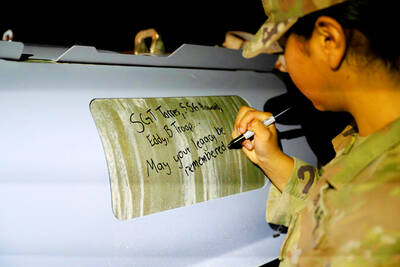About 20 percent of adolescents in the US have had sexual intercourse before their 15th birthday -- and one in seven of the sexually experienced 14-year-old girls has been pregnant, according to a new report released on Monday by the National Campaign to Prevent Teen Pregnancy.
The report, an analysis of seven studies conducted in the late 1990s, offers a comprehensive look at the sexual activities of 12- to 14-year-olds, a group often overlooked in discussions of adolescent sexuality.
"These are not new data sets, but I think this is the first time we've put together all these numbers in a way that tells the story about young people this age," said Sarah Brown, director of the campaign, a nonprofit, nonpartisan group based in Washington.
"Remember, a lot of researchers, as well as a lot of people who fund research, are reluctant to ask questions about sexual behavior to very young people, so there's not an enormous amount of information about this age group.
"This is a wake-up call that the efforts that we make toward young people have to start early, that teachers looking at a class of 13-year-olds can't assume they're in a state of latent innocence."
Brown and others said there was reason to believe that in the years since the data was collected, fewer young teenagers had been having sex.
For those 14 and younger, according to federal data, the birthrate declined 43 percent from 1991 to 2001, while the decline for older teenagers was 27 percent.
According to information released this month by the Alan Guttmacher Institute, the pregnancy rate for 12- to 14-year-olds dropped 40 percent from 1990 to 1999.
The study found that only about a third of parents of sexually experienced 14-year-olds knew that their children were having sex.
While most parents said they had spoken to their young adolescent children about sex, far fewer teenagers reported having had such conversations with their parents.
In addition to the obvious concerns about pregnancy and sexually transmitted diseases, the report found that young adolescents who were sexually experienced were far more likely than virgins to engage in other risky behaviors, like smoking, drinking and using drugs.
For example, 18 percent of the sexually experienced young people reported drinking regularly, compared with 3 percent of the virgins. Similarly 29 percent of the sexually experienced adolescents said they had smoked regularly and 43 percent had used marijuana, compared with 8 percent and 10 percent of the virgins.
The report found that young teenagers have ample opportunity to have sex. About half of 14-year-olds have attended a party with no adult supervision, and about a third said that within the last three months, they had lain on a bed or couch alone with someone they liked.
From half to three-quarters of the experienced 12- to 14-year-olds said they had used contraception the first time they had sex.
About a quarter of the 12- to 14-years-olds had dated or had a romantic relationship with someone at least two years older -- and the greater the age difference, the more likely the relationship was to have included sexual intercourse, the study found.
"When parents ask me what they can do, I tell them two things," Brown said.
"First, discourage early one-on-one dating, and second, be very, very leery of significant age differences," Brwon said.
According to the report, many of those who lose their virginity before age 15 have had sex sporadically.
One of the studies found that 4 in 10 of the sexually experienced young people had had sex in the 18 months preceding the survey, and another found that half of those who were no longer virgins had engaged in intercourse twice or less in the last year.
The data in the report comes from three federally financed surveys of young people and four smaller data sets.

The Burmese junta has said that detained former leader Aung San Suu Kyi is “in good health,” a day after her son said he has received little information about the 80-year-old’s condition and fears she could die without him knowing. In an interview in Tokyo earlier this week, Kim Aris said he had not heard from his mother in years and believes she is being held incommunicado in the capital, Naypyidaw. Aung San Suu Kyi, a Nobel Peace Prize laureate, was detained after a 2021 military coup that ousted her elected civilian government and sparked a civil war. She is serving a

REVENGE: Trump said he had the support of the Syrian government for the strikes, which took place in response to an Islamic State attack on US soldiers last week The US launched large-scale airstrikes on more than 70 targets across Syria, the Pentagon said on Friday, fulfilling US President Donald Trump’s vow to strike back after the killing of two US soldiers. “This is not the beginning of a war — it is a declaration of vengeance,” US Secretary of Defense Pete Hegseth wrote on social media. “Today, we hunted and we killed our enemies. Lots of them. And we will continue.” The US Central Command said that fighter jets, attack helicopters and artillery targeted ISIS infrastructure and weapon sites. “All terrorists who are evil enough to attack Americans are hereby warned

Seven wild Asiatic elephants were killed and a calf was injured when a high-speed passenger train collided with a herd crossing the tracks in India’s northeastern state of Assam early yesterday, local authorities said. The train driver spotted the herd of about 100 elephants and used the emergency brakes, but the train still hit some of the animals, Indian Railways spokesman Kapinjal Kishore Sharma told reporters. Five train coaches and the engine derailed following the impact, but there were no human casualties, Sharma said. Veterinarians carried out autopsies on the dead elephants, which were to be buried later in the day. The accident site

‘EAST SHIELD’: State-run Belma said it would produce up to 6 million mines to lay along Poland’s 800km eastern border, and sell excess to nations bordering Russia and Belarus Poland has decided to start producing anti-personnel mines for the first time since the Cold War, and plans to deploy them along its eastern border and might export them to Ukraine, the deputy defense minister said. Joining a broader regional shift that has seen almost all European countries bordering Russia, with the exception of Norway, announce plans to quit the global treaty banning such weapons, Poland wants to use anti-personnel mines to beef up its borders with Belarus and Russia. “We are interested in large quantities as soon as possible,” Deputy Minister of National Defense Pawel Zalewski said. The mines would be part